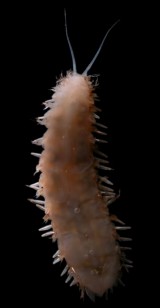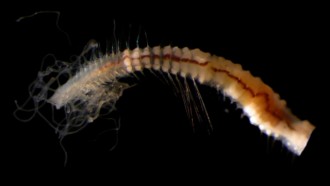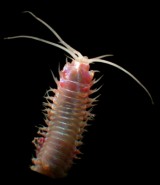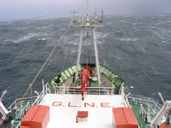Crozet worm blog
18/12/05
by Adrian Glover
What am I doing in the middle of the Southern
Ocean, 1000 miles from anywhere, collecting worms? And in
particular, why should anyone care about worms from the Crozet
Islands of all places? Despite the occasional few minutes
of self-doubt, lying awake at night in my cabin aboard RRS
Discovery, I can, I think, answer this question. For one thing,
it turns out that worms are rather more common than you might
think. The earth’s surface is over 60% ocean, and take
any sample of the seabed of that ocean – with a bucket,
trawl, or dredge – and the chances are you will bring
up a large handful of worms, especially polychaetes –
marine segmented worms which are known for their ‘hairy’
appearance. These things are so dominant in the marine realm,
that an alien from outer space, randomly sub-sampling planet
Earth for life, would most likely bring up a load of polychaetes
in their first samples.

The ‘worm’ lab…
So they are common, but what do they do? And
most importantly, why should anyone care? This question can
be answered in two ways. Firstly, because the abyssal plains
(such as those around the Crozet Islands) are so remote and
difficult to sample, we have really very little knowledge
of this group of organisms. So, for the most part, we don’t
know what they do. But the research that has been carried
out shows that they are incredibly biodiverse, with perhaps
thousands, even millions of undescribed species in the deep
sea. The first step in understanding an ecosystem is to describe
the animals that live there, and to compare these new species
with those we have found from elsewhere. This gives an idea
of the ‘community’ of animals living in this region,
and how similar – or different – it is to other
places that we know much better. Describing these new species
also allows us to place them in their evolutionary context,
on the ‘tree of life’, which helps us to understand
how and why these things evolved in the first place.

Somewhere in this bucket is a worm that
is going to change the world!
The second part is perhaps more complicated.
What function do these worms perform? Worms that live on abyssal
plains, 4000m from the surface of the ocean, are detritivores,
consuming ‘detritus’ (dead organic-rich material)
that has fallen from the surface layers of the ocean, where
photosynthesis takes place. Hence they perform the rather
important function of recycling organic material at the seafloor.
The abundance and community structure of the worms, can help
us to understand the processes occurring in the ocean above.
We can measure various wormy parameters (e.g. how abundant,
how many species, what function they perform) and compare
this with what we know about the biology of the ocean above
them.

The USNEL spade box core. Advanced ‘bucket
and spade’ technology.
So that is the reason I am here. There are worms
down there, and somebody needs to sort them out. One of the
other cool things about polychaetes is that they are actually
quite pretty. So here are some pictures of polychaetes (taken
down the microscope) from our recent trawl and box core samples
at station M5:

A large scale-worm from the abyssal plains of Crozet. |
 A cirratulid polychaete brought
up in a box core.
A cirratulid polychaete brought
up in a box core. |
 This large, onuphid polychaete
is abundant in our trawls and lives in muddy tubes.
This large, onuphid polychaete
is abundant in our trawls and lives in muddy tubes. |
|
Click on the
pictures for a larger version. Opens in new window/tab |
 |
